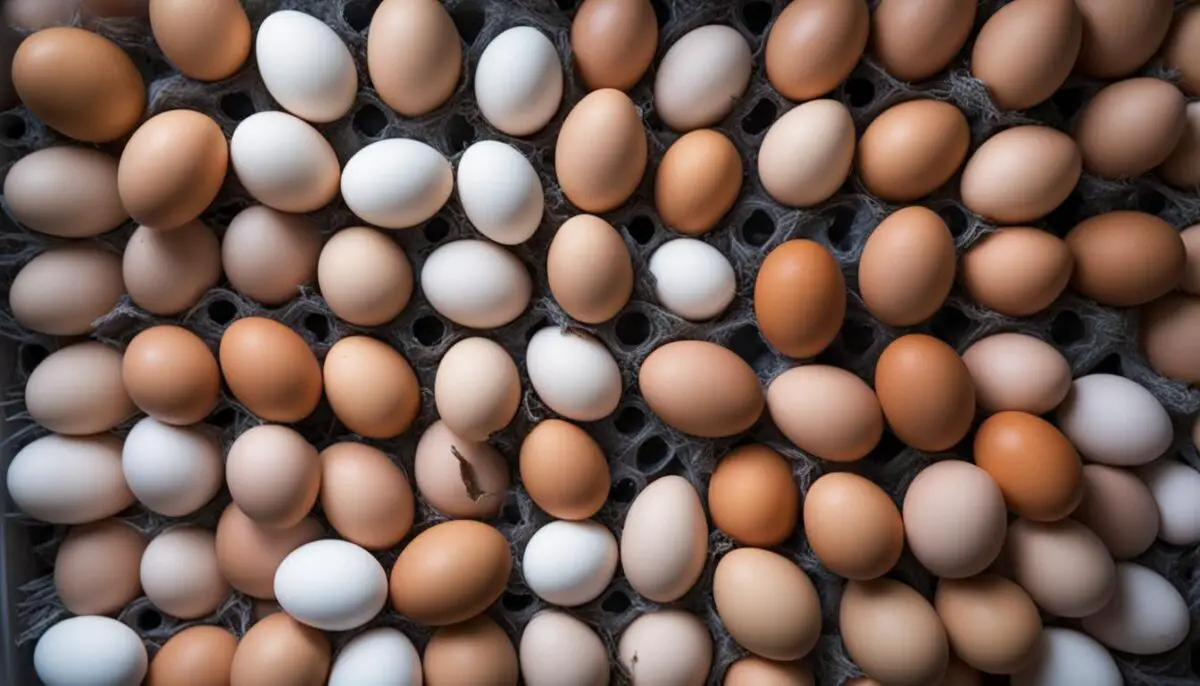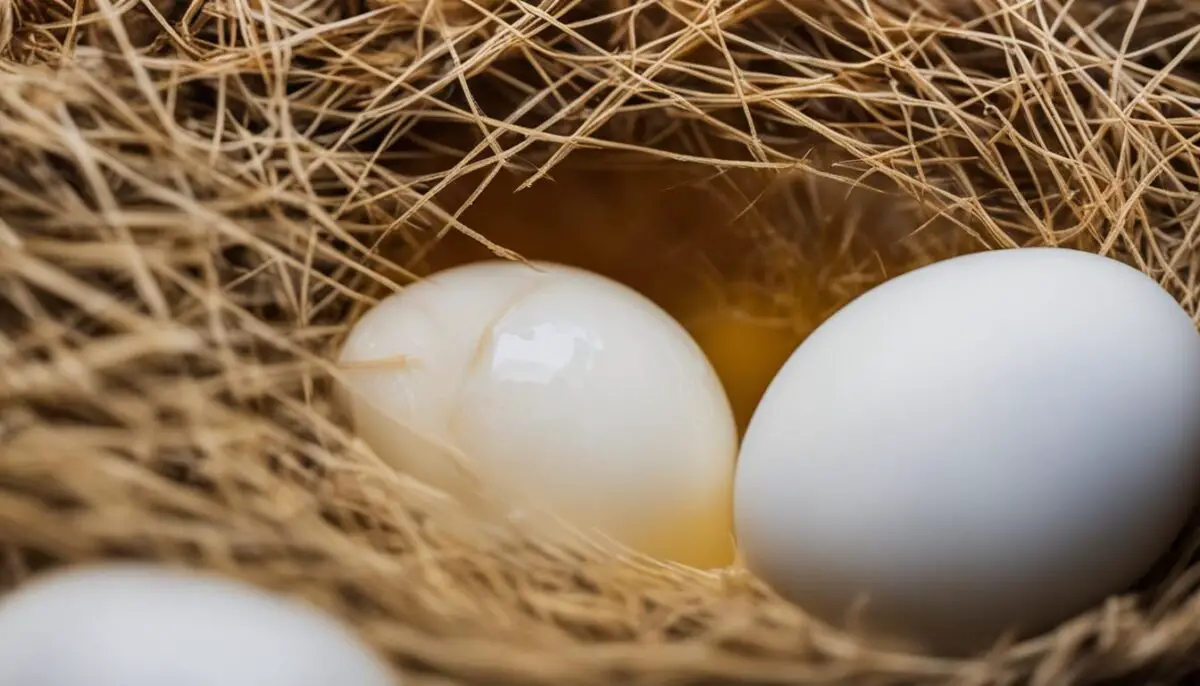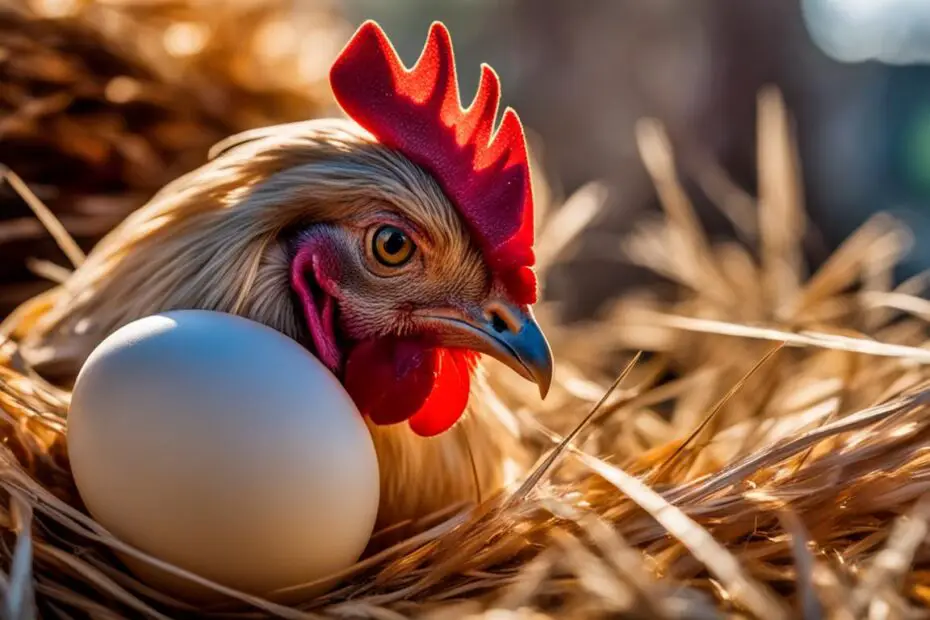Do you want to experience the joy of hatching your own chickens? Understanding the chicken egg hatching time is essential for a successful hatching process. From the incubation period to the different stages of development, there are important factors to consider. Let’s dive into the fascinating world of chicken egg hatching!
Key Takeaways:
- The incubation period for chicken eggs is typically 21 days.
- Only fertile eggs can be hatched, not the ones sold in grocery stores.
- Temperature and humidity control play a crucial role in successful hatching.
- Turning the eggs and candling are important steps during incubation.
- Allow the chicks to hatch naturally and provide proper care after hatching.
Choosing the Right Incubator for Hatching Chicken Eggs
When it comes to hatching chicken eggs, choosing the right incubator is crucial for ensuring successful results. There are several types of incubators available on the market, each with its own features and level of automation. Understanding the factors that affect the hatching process and considering personal preferences are key when selecting an incubator.
Manual incubators are a suitable option for those who prefer a more hands-on approach. With manual incubators, temperature and humidity levels need to be manually adjusted throughout the incubation period. This type of incubator requires regular monitoring and attention to maintain the optimal conditions for hatching.
Mostly automated incubators offer a middle ground between manual and fully automated models. These incubators come with some automatic features, such as egg turning, which helps promote proper embryo development. While manual adjustments may still be required, mostly automated incubators reduce the amount of manual labor involved in the hatching process.
Fully automated incubators provide the highest level of automation and convenience. These advanced models control temperature, humidity, and egg turning, making the hatching process virtually hands-free. Fully automated incubators offer precise temperature and humidity control, minimizing the risk of human error and maximizing the chances of successful hatching.
Factors such as temperature, humidity, and egg turning play significant roles in the hatching process. By selecting an incubator that aligns with these factors and following the manufacturer’s instructions, the chances of a successful hatch can be greatly improved.
| Incubator Type | Features | Level of Automation |
|---|---|---|
| Manual Incubators | Requires manual adjustment of temperature and humidity | Low |
| Mostly Automated Incubators | Automatic egg turning, some manual adjustments | Medium |
| Fully Automated Incubators | Automatic temperature, humidity, and egg turning | High |
When choosing an incubator, consider the desired level of automation, personal preferences, and budget. It’s important to invest in a reliable incubator that can maintain consistent temperature and humidity levels. By selecting the right incubator and providing the optimal conditions for hatching, you can increase the chances of successfully hatching chicks from eggs.

Quote:
“Choosing the right incubator is essential for creating the ideal environment for hatching chicken eggs. By selecting an incubator that aligns with your preferences and provides the necessary features, you can increase the chances of a successful hatch.” – Poultry Expert
Incubating Chicken Eggs: Temperature and Humidity Control
Proper temperature and humidity control are crucial factors that determine the successful hatching of chicken eggs. Maintaining the correct environment is essential for the healthy development of the embryos throughout the incubation period.
“To hatch chicken eggs successfully, it is important to provide the ideal conditions of temperature and humidity.”
Temperature Control
The recommended temperature range for incubating chicken eggs is between 99-102 degrees Fahrenheit, with an optimum temperature of 100.5 degrees Fahrenheit. It is crucial to ensure the accuracy of the incubator’s thermometer to maintain the desired temperature. The thermometer should be placed in the middle of the incubator near the eggs for accurate readings.
Consistency is key when it comes to temperature control. Fluctuations and extreme temperature variations can negatively impact the development of the embryos. It is advisable to regularly monitor the temperature and make any adjustments necessary to stay within the recommended range.
Humidity Control
Humidity plays a vital role in the incubation process. During the first 17 days, the humidity level should be maintained at around 50-55%. On day 18, the humidity should be raised to approximately 70%. Adequate humidity promotes the proper development of the embryos and prevents the eggs from drying out.
Water channels within the incubator should be filled to ensure a consistently humid environment. This helps maintain the necessary moisture levels within the incubator. It is important to avoid unnecessary opening of the incubator, as it can affect the temperature and humidity inside.
The Importance of Temperature and Humidity
Proper temperature and humidity control are essential for the development of the embryos inside the chicken eggs. The right conditions ensure optimal growth, leading to successful hatching at the expected time.
Incorrect temperature or humidity levels can result in irregular or delayed hatching, deformities, or even the unsuccessful development of the embryos. It is crucial to closely monitor and regulate the incubator conditions to provide the best possible environment for the eggs.

| Temperature | Humidity |
|---|---|
| 99-102 degrees Fahrenheit | 50-55% for the first 17 days |
| Optimum: 100.5 degrees Fahrenheit | Raised to 70% on day 18 |
Turning and Candling Chicken Eggs During Incubation
Turning and candling are crucial steps in the incubation process of chicken eggs. They play a vital role in ensuring the proper development of the embryos and increasing the chances of successful hatching.
Turning the Eggs
Turning the eggs is important to prevent the developing embryo from sticking to the shell and to promote healthy development. The embryos need regular movement and exercise inside the egg for optimal growth.
Eggs should be turned a minimum of 3 times a day, preferably 5 times, to provide the embryos with the necessary exercise and the correct movement. Manual turning can be done by marking the eggs and alternating their positions. This simple rotation helps distribute the heat evenly and prevents the embryo from adhering to the shell.
| Number of Turns per Day | Benefits |
|---|---|
| 3 times | Basic movement for healthy development |
| 5 times | Increased exercise and movement for optimal growth |
Some modern incubators come with automatic egg turners that rotate the eggs automatically. This eliminates the need for manual turning and ensures consistent movement for the embryos throughout the incubation period.
Candling the Eggs
Candling is the process of shining a light through the shell to observe the development of the embryo inside. It serves as a valuable tool to monitor the growth and well-being of the developing chicks.
Candling is typically performed around days 7-10 of incubation. During this stage, it is possible to see the growth of blood vessels and the formation of structures such as the chick’s eyes and beak.
One of the primary purposes of candling is to identify any eggs that are not viable. Infertile or non-developing eggs can be detected early and removed from the incubator, preventing unnecessary energy and resources from being wasted on them.
“Candling allows us to peek into the mysterious world of the developing embryo. It’s like having a window into the miracle of life.”

By combining regular turning and effective candling, you can ensure that the chicken eggs are given the best conditions for successful hatching. These practices contribute to the healthy development of the embryos and increase your chances of seeing adorable chicks emerge from their shells.
Pre-Hatching and Handling of Hatched Chicks
On day 18 of incubation, it is important to stop turning the eggs to allow the chicks to position themselves for hatching. During this time, the temperature should be maintained at 100.5 degrees Fahrenheit, while the humidity should be increased to 70%. These conditions create the ideal environment for the chicks to hatch successfully.
Typically, chicks start hatching on day 21 of incubation. They use their beaks to peck through the shell and gradually emerge over a period of several hours. It is crucial not to intervene or help the chicks during this hatching process, as premature assistance can cause harm and interfere with their natural development.
Once the chicks have fully hatched, it is important to leave them in the incubator until they are completely dry. The drying process helps strengthen their feathers and prepare them for life outside the shell. After the chicks are dry, they can be gently moved to a brooder, a designated space where they can grow and thrive.
The brooder should be set up with supplemental heat, as the chicks still require warmth to stay healthy. It is essential to provide them with a temperature-controlled environment to mimic the conditions they experienced in the incubator. Additionally, the brooder should have access to food and water to ensure the chicks’ nutritional needs are met.
Tips for Handling Hatched Chicks:
- Handle the chicks with care to avoid causing stress or harm.
- Ensure the brooder is clean and free of any potential hazards.
- Monitor the chicks’ health and behavior closely, watching for any signs of illness.
- Gradually introduce the chicks to their new surroundings and any flockmates.
- Provide appropriate nutrition and fresh water at all times.
- Enjoy observing the chicks as they grow and develop into healthy chickens!
In summary, the pre-hatching and handling of hatched chicks is a crucial part of the chicken egg hatching process. By allowing the chicks to hatch naturally and providing them with the right conditions and care, you can ensure their successful transition from the incubator to the brooder and ultimately watch them grow into thriving members of your backyard flock.
Conclusion
Hatching chicks from eggs is a fascinating and fulfilling journey that requires careful attention to detail and a bit of patience. Understanding the chicken egg hatching time of approximately 21 days and following the recommended guidelines is essential for a successful outcome.
By maintaining the right temperature and humidity levels in the incubator, ensuring regular egg turning, and monitoring the development stages through candling, you can provide the optimal conditions for the embryos to grow and eventually hatch into adorable baby chicks.
Witnessing the moment when the chicks crack through their shells, emerge, and take their first steps is a truly delightful experience. These precious hatchlings will grow into healthy members of your backyard flock, bringing joy and vitality to your homestead.
FAQ
What is the hatching time for chicken eggs?
Hatching chicken eggs typically takes 21 days.
How long does it take for a chicken egg to hatch?
Chicken eggs usually hatch in about 21 days.
What is the incubation time for chicken eggs?
The incubation period for chicken eggs is 21 days.
What are the stages of chicken egg development?
The stages of chicken egg development include egg turning, candling, and pre-hatching.
How can I choose the right incubator for hatching chicken eggs?
The choice of an incubator depends on personal preference and the desired level of automation.
What factors affect the hatching time for chicken eggs?
Factors such as temperature, humidity, and turning of the eggs can affect the hatching time.
How can I incubate chicken eggs?
To incubate chicken eggs, you need to carefully control the temperature and humidity levels in an incubator.
How can I maintain the correct temperature and humidity levels during incubation?
The recommended temperature range for incubation is 99-102 degrees Fahrenheit, with an optimum temperature of 100.5 degrees Fahrenheit. The humidity level should be around 50-55% during the first 17 days and then raised to 70% on day 18.
Why is egg turning important during incubation?
Turning the eggs prevents the developing embryo from sticking to the shell and ensures proper development.
What is candling and when should it be done?
Candling is a process of shining a light through the shell to observe the embryo’s development. It is typically done around days 7-10 of incubation to determine if the embryos are growing properly.
What should I do on day 18 of incubation?
On day 18 of incubation, you should stop turning the eggs to allow the chicks to position themselves for hatching.
When do chicks start hatching?
Chicks typically start hatching on day 21 of incubation.
How should I handle hatched chicks?
Once the chicks have hatched, they should be left in the incubator until they are completely dry. After they are dry, they can be moved to a brooder.
Can I intervene or help the chicks during the hatching process?
It is important not to intervene or help the chicks during the hatching process, as premature assistance can cause harm.
How long does it take for a chicken egg to hatch?
Chicken eggs usually hatch in about 21 days.
What is the hatching time for chicken eggs?
Hatching chicken eggs typically takes 21 days.

